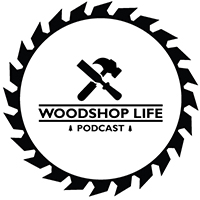Support us on Patreon: https://www.patreon.com/woodshoplife
Guy
1) Dear Guy / Huy / Sean – First off, thank you for the podcast you produce. It is the only podcast I listen to that I have to pull over in the car to take notes on the way to work. I wish I lived closer to any of you to interact with you on a personal level instead of only podcasts. Anyway…my question has to do with needing advice on what to do with a crazy looking piece of burl. I have been helping my parents move out of their lifelong home and have “inherited” lots of wood from my Dad. The most interesting wood is a wild piece of knobby burl (not sure the species). I’m struggling with what to do with it though. It’s roughly 6″ per side but has many ‘branches’. I can send a pic if needed but wasn’t sure how on the website. I have essentially all the needed woodworking equipment including a mini-lathe but cannot figure out what to do with such a weird piece. I would love to make something unique but cannot figure out what to make out of this crazy wood. I would appreciate any creative advice you can give. P.S. – Guy – the desk you built was jaw dropping and I saved several pics. That desk is the inspiration for my someday desk. I wish I lived in Indiana to work alongside you as it seems like you have a dream job. Huy – similar story to you as well. As an engineer, I tried to get on with NASA but that path is not for me it appears. Sean – I’m not sure what your personal life is like as you seem somewhat reserved but I feel like we have parallel lives! We would make good neighbors / friends I think. Thank you all for that you guys do. Keep the saw dust flying! Cheers, Greg
2) Hi Gents,
Thanks for the great podcast and constantly sharing your knowledge, war stories and humor every 2 weeks. It’s always a good day when the Woodshop Life shows up in my podcast feed.
That’s enough about how great you all are – onto my question.
For the 8+ years I’ve been wood working I’ve constantly heard that you should lightly spray your project with water to raise the grain and sand back before applying finish. So my question is what’s the advantage of using water to raise the grain? Why not apply a light coat of Shellac or poly to raise the grain and then sand back and you’re a coat of finish further on? Is there any advantage to using water?
Thanks again for everything you do.
Regards, John McGrath, Houston, TX
3) Hey Guys, love listening to your podcast while in the shop. As an Asian American who does woodworking, really appreciate seeing, and hearing, from other Asian Americans like Huy who share the same interest in this space. My question for you guys: I am making a round dining table. The top will be glued up walnut planks with a 51 inch diameter. The base will be pedestal style base with a diameter of around 22 inches. It will be constructed out of bent plywood (using kerf relief cuts and veneering the outside with walnut) and hollow inside except for some cross braces for rigidity. I plan on sealing the bottom with either (1) a 22 inch diameter plywood( or solid wood) base to cover the bottom and add weights inside the base to make sure the top doesn’t tip over or (2) a larger than 22″ diameter base. My questions is if I do the first option, is there a calculation as to minimum weight is needed to make sure the solid walnut top of 51″ won’t tip over?
Or if I do option 2, how large of a bottom base to do I need to prevent tip over? Is there a calculation for that? I think option 1 is a cleaner and preferred look, but I don’t want to risk tipping over and crushing a child or a toe.
Thanks in advance and look forward to listening to the next podcast. Dennis
Huy
1) Almost done with the nightstands I have been working on and asking questions about the past month. Made from two hand sawn walnut logs I salvaged etc. Out of logs. Drawer front is 1/2″ too narrow side to side. Solution is to put a 1/4″ edge band on the drawers. Problem solved. But I decided to make it complicated. Want to do 1/2″ edge band on the top as well. Should I just glue this on or attempt to make the smallest breadboard ends ever? By my math I would have 1/2″ strips- 1/8″ shoulder 1/8″ peg 1/8″ tenon past that and 1/8″ on the strip covering it up. Is this necessary, feel like I am making dollhouse furniture here after the shed and 10′ long bookshelves I just finished. Edge banding would run across the grain, 14″ x 12.5″ x .625″ (5/8) top, ripped and glued as per my question a month ago, picture below for reference. Tom
2)Thanks for the amazing podcast. You fellas have answered my questions and were very helpful! I”m having trouble centering my hollow chisel mortiser. I used the “X” method. Mark a horizontal line and then two opposing 45’s to get center. I have used a marking gauge, and kept adjusting till it lands on the same mark. I then adjust my x and y axis table to hit center, then it’s not center.
Any thoughts would be great! Thanks so much!
Scott Bonin
